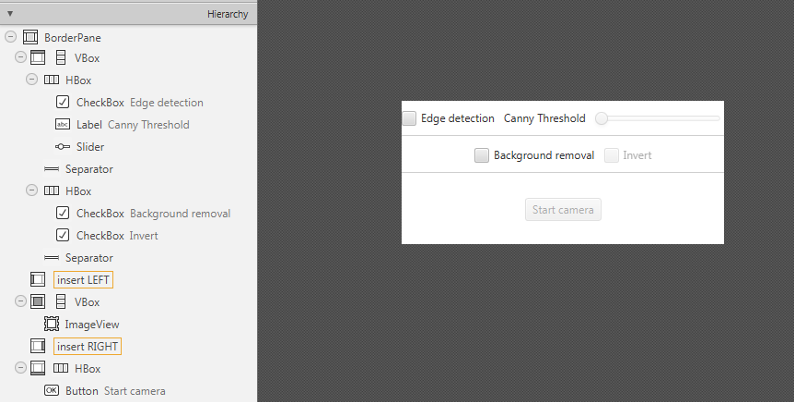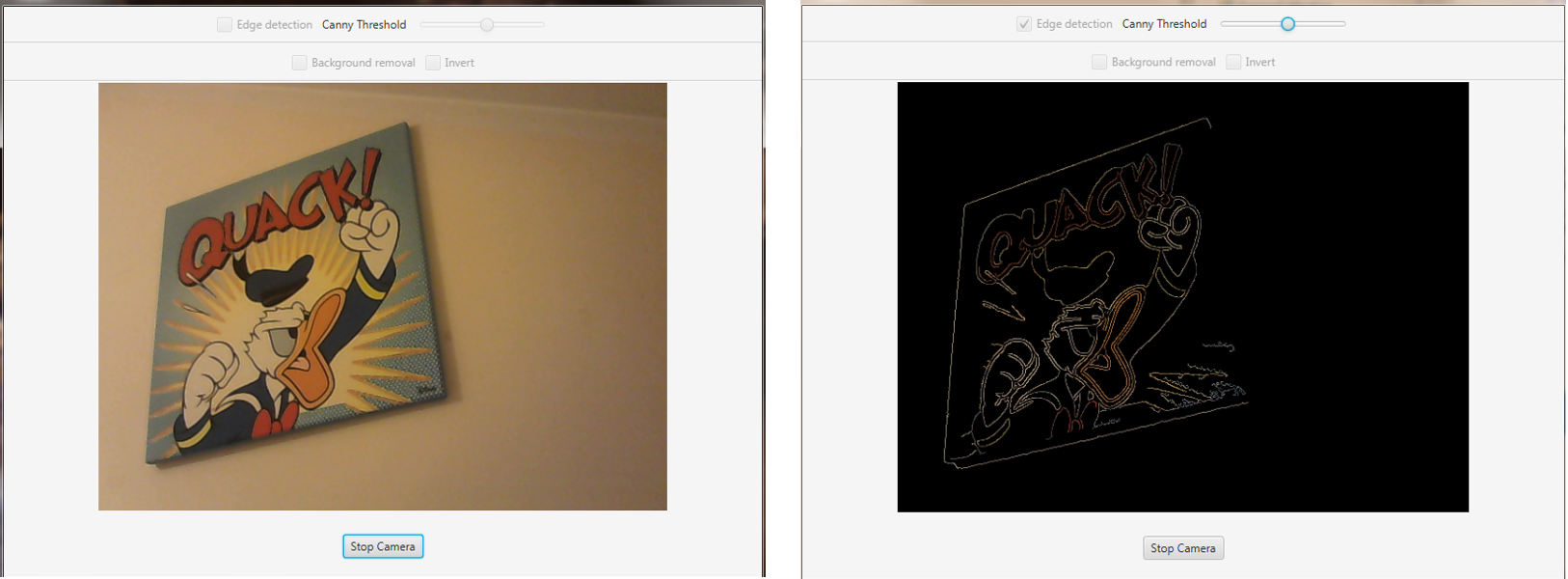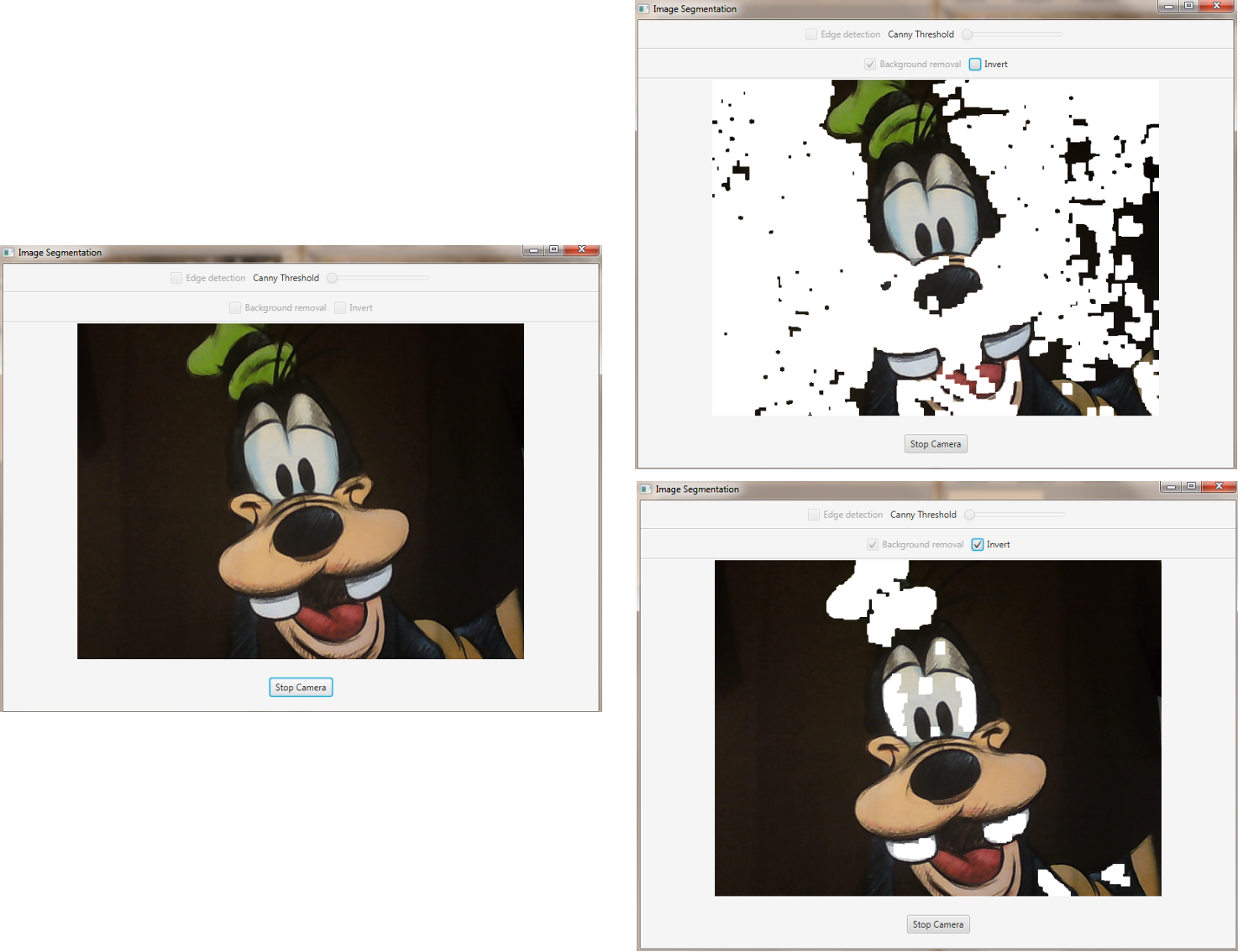Image Segmentation¶
Note
We assume that by now you have already read the previous tutorials. If not, please check previous tutorials at http://polito-java-opencv-tutorials.readthedocs.org/en/latest/index.html. You can also find the source code and resources at https://github.com/java-opencv/Polito-Java-OpenCV-Tutorials-Source-Code
Goal¶
In this tutorial we are going to create a JavaFX application where we can decide to apply to video stream captured from our web cam either a Canny edge detector or a Background removal using the two basic morphological operations: dilatation and erosion.
Canny edge detector¶
The Canny edge detector is an edge detection operator that uses a multi-stage algorithm to detect a wide range of edges in images. It was developed by John F. Canny in 1986.
- Canny edge detection is a four step process:
- A Gaussian blur is applied to clear any speckles and free the image of noise.
- A gradient operator is applied for obtaining the gradients’ intensity and direction.
- Non-maximum suppression determines if the pixel is a better candidate for an edge than its neighbors.
- Hysteresis thresholding finds where edges begin and end.
- The Canny algorithm contains a number of adjustable parameters, which can affect the computation time and effectiveness of the algorithm.
- The size of the Gaussian filter: the smoothing filter used in the first stage directly affects the results of the Canny algorithm. Smaller filters cause less blurring, and allow detection of small, sharp lines. A larger filter causes more blurring, smearing out the value of a given pixel over a larger area of the image.
- Thresholds: A threshold set too high can miss important information. On the other hand, a threshold set too low will falsely identify irrelevant information (such as noise) as important. It is difficult to give a generic threshold that works well on all images. No tried and tested approach to this problem yet exists.
For our purpose we are going to set the filter size to 3 and the threshold editable by a Slider.
Dilatation and Erosion¶
Dilation and erosion are the most basic morphological operations. Dilation adds pixels to the boundaries of objects in an image, while erosion removes pixels on object boundaries. The number of pixels added or removed from the objects in an image depends on the size and shape of the structuring element used to process the image. In the morphological dilation and erosion operations, the state of any given pixel in the output image is determined by applying a rule to the corresponding pixel and its neighbors in the input image. The rule used to process the pixels defines the operation as a dilation or an erosion.
Dilatation: the value of the output pixel is the maximum value of all the pixels in the input pixel’s neighborhood. In a binary image, if any of the pixels is set to the value 1, the output pixel is set to 1.
Erosion: the value of the output pixel is the minimum value of all the pixels in the input pixel’s neighborhood. In a binary image, if any of the pixels is set to 0, the output pixel is set to 0.
What we will do in this tutorial¶
- In this guide, we will:
- Add a checkbox and a Slider to select and control the Canny edge detector.
- Use the Canny edge function provided by OpenCV.
- Use the Dilatation and erosion functions provided by OpenCV.
- Create a background removal function.
Getting Started¶
Let’s create a new JavaFX project. In Scene Builder set the windows element so that we have a Border Pane with:
- on TOP a VBox containing two HBox, each one followed by a separator.
In the first HBox we are goning to need a checkbox and a slider, the first one is to select the Canny e.d. mode and the second one is going to be used to control the value of the threshold to be passed to the Canny e.d. function.
<CheckBox fx:id="canny" onAction="#cannySelected" text="Edge detection"/> <Label text="Canny Threshold" /> <Slider fx:id="threshold" disable="true" />In the second HBox we need two checkboxes, the first one to select the Backgrond removal mode and the second one to say if we want to invert the algorithm (a sort of “foreground removal”).
<CheckBox fx:id="dilateErode" onAction="#dilateErodeSelected" text="Background removal"/> <CheckBox fx:id="inverse" text="Invert" disable="true"/>
- in the CENTRE we are going to put an ImageView for the web cam stream.
<ImageView fx:id="originalFrame" />
- on the BOTTOM we can add the usual button to start/stop the stream
<Button fx:id="cameraButton" alignment="center" text="Start camera" onAction="#startCamera" disable="true" />
The gui will look something like this one:

Using the Canny edge detection¶
If we selected the Canny checkbox we can perform the method doCanny.
if (this.canny.isSelected()){
frame = this.doCanny(frame);
}
doCanny is a method that we define to execute the edge detection.
First, we convert the image into a grayscale one and blur it with a filter of kernel size 3:
Imgproc.cvtColor(frame, grayImage, Imgproc.COLOR_BGR2GRAY);
Imgproc.blur(grayImage, detectedEdges, new Size(3, 3));
Second, we apply the OpenCV function Canny:
Imgproc.Canny(detectedEdges, detectedEdges, this.threshold.getValue(), this.threshold.getValue() * 3, 3, false);
- where the arguments are:
detectedEdges: Source image, grayscaledetectedEdges: Output of the detector (can be the same as the input)this.threshold.getValue(): The value entered by the user moving the Sliderthis.threshold.getValue() * 3: Set in the program as three times the lower threshold (following Canny’s recommendation)3: The size of the Sobel kernel to be used internallyfalse: a flag, indicating whether to use a more accurate calculation of the magnitude gradient.
Then we fill a dest image with zeros (meaning the image is completely black).
Mat dest = new Mat();
Core.add(dest, Scalar.all(0), dest);
Finally, we will use the function copyTo to map only the areas of the image that are identified as edges (on a black background).
frame.copyTo(dest, detectedEdges);
copyTo copies the src image onto dest. However, it will only copy the pixels in the locations where they have non-zero values.
Canny Result¶

Using the Background Removal¶
If we seletced the background removal checkbox we can perform the method doBackgroundRemoval
else if (this.dilateErode.isSelected())
{
frame = this.doBackgroundRemoval(frame);
}
doBackgroundRemoval is a method that we define to execute the background removal.
Fisrt we need to convert the current frame in HVS:
hsvImg.create(frame.size(), CvType.CV_8U);
Imgproc.cvtColor(frame, hsvImg, Imgproc.COLOR_BGR2HSV);
Now let's split the three channels of the image:
Core.split(hsvImg, hsvPlanes);
Calculate the Hue component mean value:
Imgproc.calcHist(hue, new MatOfInt(0), new Mat(), hist_hue, histSize, new MatOfFloat(0, 179));
for (int h = 0; h < 180; h++)
average += (hist_hue.get(h, 0)[0] * h);
average = average / hsvImg.size().height / hsvImg.size().width;
If the background is uniform and fills most of the frame, its value should be close to mean just calculated. Then we can use the mean as the threshold to separate the background from the foreground, depending on the invert chackbox we need to perform a back(fore)ground removal:
if (this.inverse.isSelected())
Imgproc.threshold(hsvPlanes.get(0), thresholdImg, threshValue, 179.0, Imgproc.THRESH_BINARY_INV);
else
Imgproc.threshold(hsvPlanes.get(0), thresholdImg, threshValue, 179.0, Imgproc.THRESH_BINARY);
Now we apply a low pass filter (blur) with a 5x5 kernel mask to enhance the result:
Imgproc.blur(thresholdImg, thresholdImg, new Size(5, 5));
Finally apply the dilatation then the erosion (closing) to the image:
Imgproc.dilate(thresholdImg, thresholdImg, new Mat(), new Point(-1, 1), 6);
Imgproc.erode(thresholdImg, thresholdImg, new Mat(), new Point(-1, 1), 6);
- The functions take these parameters:
thresholdImginput image;thresholdImgoutput image of the same size and type as thresholdImg;new Mat()a kernel;new Point(-1, 1)position of the anchor within the element; default value ( -1, 1 ) means that the anchor is at the element center.6number of times the operation is applied.
After the closing we need to do a new binary threshold:
Imgproc.threshold(thresholdImg, thresholdImg, threshValue, 179.0, Imgproc.THRESH_BINARY);
At last, we can apply the image we’ve just obtained as a mask to the original frame:
Mat foreground = new Mat(frame.size(), CvType.CV_8UC3, new Scalar(255, 255, 255));
frame.copyTo(foreground, thresholdImg);
Background Removal Result¶

Source Code¶
public class ImageSegmentation extends Application {
@Override
public void start(Stage primaryStage)
{
try
{
// load the FXML resource
BorderPane root = (BorderPane) FXMLLoader.load(getClass().getResource("IS_FX.fxml"));
// set a whitesmoke background
root.setStyle("-fx-background-color: whitesmoke;");
// create and style a scene
Scene scene = new Scene(root, 800, 600);
scene.getStylesheets().add(getClass().getResource("application.css").toExternalForm());
// create the stage with the given title and the previously created
// scene
primaryStage.setTitle("Image Segmentation");
primaryStage.setScene(scene);
// show the GUI
primaryStage.show();
}
catch (Exception e)
{
e.printStackTrace();
}
}
public static void main(String[] args)
{
// load the native OpenCV library
System.loadLibrary(Core.NATIVE_LIBRARY_NAME);
launch(args);
}
}
public class IS_Controller {
// FXML buttons
@FXML
private Button cameraButton;
// the FXML area for showing the current frame
@FXML
private ImageView originalFrame;
// checkbox for enabling/disabling Canny
@FXML
private CheckBox canny;
// canny threshold value
@FXML
private Slider threshold;
// checkbox for enabling/disabling background removal
@FXML
private CheckBox dilateErode;
// inverse the threshold value for background removal
@FXML
private CheckBox inverse;
// a timer for acquiring the video stream
private Timer timer;
// the OpenCV object that performs the video capture
private VideoCapture capture = new VideoCapture();
// a flag to change the button behavior
private boolean cameraActive;
private Image CamStream;
/**
* The action triggered by pushing the button on the GUI
*/
@FXML
protected void startCamera()
{
if (!this.cameraActive)
{
// disable setting checkboxes
this.canny.setDisable(true);
this.dilateErode.setDisable(true);
// start the video capture
this.capture.open(0);
// is the video stream available?
if (this.capture.isOpened())
{
this.cameraActive = true;
// grab a frame every 33 ms (30 frames/sec)
TimerTask frameGrabber = new TimerTask() {
@Override
public void run()
{
CamStream = grabFrame();
Platform.runLater(new Runnable() {
@Override
public void run() {
// show the original frames
originalFrame.setImage(CamStream);
// set fixed width
originalFrame.setFitWidth(600);
// preserve image ratio
originalFrame.setPreserveRatio(true);
}
});
}
};
this.timer = new Timer();
this.timer.schedule(frameGrabber, 0, 33);
// update the button content
this.cameraButton.setText("Stop Camera");
}
else
{
// log the error
System.err.println("Failed to open the camera connection...");
}
}
else
{
// the camera is not active at this point
this.cameraActive = false;
// update again the button content
this.cameraButton.setText("Start Camera");
// enable setting checkboxes
this.canny.setDisable(false);
this.dilateErode.setDisable(false);
// stop the timer
if (this.timer != null)
{
this.timer.cancel();
this.timer = null;
}
// release the camera
this.capture.release();
// clean the image area
originalFrame.setImage(null);
}
}
/**
* Get a frame from the opened video stream (if any)
*
* @return the {@link Image} to show
*/
private Image grabFrame()
{
// init everything
Image imageToShow = null;
Mat frame = new Mat();
// check if the capture is open
if (this.capture.isOpened())
{
try
{
// read the current frame
this.capture.read(frame);
// if the frame is not empty, process it
if (!frame.empty())
{
// handle edge detection
if (this.canny.isSelected())
{
frame = this.doCanny(frame);
}
// foreground detection
else if (this.dilateErode.isSelected())
{
frame = this.doBackgroundRemoval(frame);
}
// convert the Mat object (OpenCV) to Image (JavaFX)
imageToShow = mat2Image(frame);
}
}
catch (Exception e)
{
// log the (full) error
System.err.print("ERROR");
e.printStackTrace();
}
}
return imageToShow;
}
/**
* Perform the operations needed for removing a uniform background
*
* @param frame
* the current frame
* @return an image with only foreground objects
*/
private Mat doBackgroundRemoval(Mat frame)
{
// init
Mat hsvImg = new Mat();
List<Mat> hsvPlanes = new ArrayList<>();
Mat thresholdImg = new Mat();
// threshold the image with the histogram average value
hsvImg.create(frame.size(), CvType.CV_8U);
Imgproc.cvtColor(frame, hsvImg, Imgproc.COLOR_BGR2HSV);
Core.split(hsvImg, hsvPlanes);
double threshValue = this.getHistAverage(hsvImg, hsvPlanes.get(0));
if (this.inverse.isSelected())
Imgproc.threshold(hsvPlanes.get(0), thresholdImg, threshValue, 179.0, Imgproc.THRESH_BINARY_INV);
else
Imgproc.threshold(hsvPlanes.get(0), thresholdImg, threshValue, 179.0, Imgproc.THRESH_BINARY);
Imgproc.blur(thresholdImg, thresholdImg, new Size(5, 5));
// dilate to fill gaps, erode to smooth edges
Imgproc.dilate(thresholdImg, thresholdImg, new Mat(), new Point(-1, 1), 6);
Imgproc.erode(thresholdImg, thresholdImg, new Mat(), new Point(-1, 1), 6);
Imgproc.threshold(thresholdImg, thresholdImg, threshValue, 179.0, Imgproc.THRESH_BINARY);
// create the new image
Mat foreground = new Mat(frame.size(), CvType.CV_8UC3, new Scalar(255, 255, 255));
frame.copyTo(foreground, thresholdImg);
return foreground;
}
/**
* Get the average value of the histogram representing the image Hue
* component
*
* @param hsvImg
* the current frame in HSV
* @param hueValues
* the Hue component of the current frame
* @return the average value
*/
private double getHistAverage(Mat hsvImg, Mat hueValues)
{
// init
double average = 0.0;
Mat hist_hue = new Mat();
MatOfInt histSize = new MatOfInt(180);
List<Mat> hue = new ArrayList<>();
hue.add(hueValues);
// compute the histogram
Imgproc.calcHist(hue, new MatOfInt(0), new Mat(), hist_hue, histSize, new MatOfFloat(0, 179));
// get the average for each bin
for (int h = 0; h < 180; h++)
{
average += (hist_hue.get(h, 0)[0] * h);
}
return average = average / hsvImg.size().height / hsvImg.size().width;
}
/**
* Apply Canny
*
* @param frame
* the current frame
* @return an image elaborated with Canny
*/
private Mat doCanny(Mat frame)
{
// init
Mat grayImage = new Mat();
Mat detectedEdges = new Mat();
// convert to grayscale
Imgproc.cvtColor(frame, grayImage, Imgproc.COLOR_BGR2GRAY);
// reduce noise with a 3x3 kernel
Imgproc.blur(grayImage, detectedEdges, new Size(3, 3));
// canny detector, with ratio of lower:upper threshold of 3:1
Imgproc.Canny(detectedEdges, detectedEdges, this.threshold.getValue(), this.threshold.getValue() * 3, 3, false);
// using Canny's output as a mask, display the result
Mat dest = new Mat();
Core.add(dest, Scalar.all(0), dest);
frame.copyTo(dest, detectedEdges);
return dest;
}
/**
* Action triggered when the Canny checkbox is selected
*
*/
@FXML
protected void cannySelected()
{
// check whether the other checkbox is selected and deselect it
if (this.dilateErode.isSelected())
{
this.dilateErode.setSelected(false);
this.inverse.setDisable(true);
}
// enable the threshold slider
if (this.canny.isSelected())
this.threshold.setDisable(false);
else
this.threshold.setDisable(true);
// now the capture can start
this.cameraButton.setDisable(false);
}
/**
* Action triggered when the "background removal" checkbox is selected
*/
@FXML
protected void dilateErodeSelected()
{
// check whether the canny checkbox is selected, deselect it and disable
// its slider
if (this.canny.isSelected())
{
this.canny.setSelected(false);
this.threshold.setDisable(true);
}
if(this.dilateErode.isSelected())
this.inverse.setDisable(false);
else
this.inverse.setDisable(true);
// now the capture can start
this.cameraButton.setDisable(false);
}
/**
* Convert a Mat object (OpenCV) in the corresponding Image for JavaFX
*
* @param frame
* the {@link Mat} representing the current frame
* @return the {@link Image} to show
*/
private Image mat2Image(Mat frame)
{
// create a temporary buffer
MatOfByte buffer = new MatOfByte();
// encode the frame in the buffer, according to the PNG format
Highgui.imencode(".png", frame, buffer);
// build and return an Image created from the image encoded in the
// buffer
return new Image(new ByteArrayInputStream(buffer.toArray()));
}
}
<BorderPane xmlns:fx="http://javafx.com/fxml/1" fx:controller="application.IS_Controller">
<top>
<VBox>
<HBox alignment="CENTER" spacing="10">
<padding>
<Insets top="10" bottom="10" />
</padding>
<CheckBox fx:id="canny" onAction="#cannySelected" text="Edge detection"/>
<Label text="Canny Threshold" />
<Slider fx:id="threshold" disable="true" />
</HBox>
<Separator />
<HBox alignment="CENTER" spacing="10">
<padding>
<Insets top="10" bottom="10" />
</padding>
<CheckBox fx:id="dilateErode" onAction="#dilateErodeSelected" text="Background removal"/>
<CheckBox fx:id="inverse" text="Invert" disable="true"/>
</HBox>
<Separator />
</VBox>
</top>
<center>
<VBox alignment="CENTER">
<padding>
<Insets right="10" left="10" />
</padding>
<ImageView fx:id="originalFrame" />
</VBox>
</center>
<bottom>
<HBox alignment="CENTER">
<padding>
<Insets top="25" right="25" bottom="25" left="25" />
</padding>
<Button fx:id="cameraButton" alignment="center" text="Start camera" onAction="#startCamera" disable="true" />
</HBox>
</bottom>
</BorderPane>